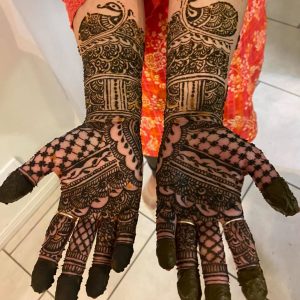Traditional Henna Art – Just an art or much more?


An art of Henna painting by females is an old tradition in many countries such as India, Africa, Indonesia, Turkey, Egypt and other Middle Eastern countries for over 9000 years (Al-Snafi, 2019). Henna symbolizes fertility and has been used cosmetically and medicinally. It’s not a newly emerged culture and henna traces have been found in the nails and toes of mummified pharoahs (Al-Snafi, 2019; Sturgell, 2011).
Henna is actually applied over hands or body by making a paste from the powder of dried leaves of Lawsonia inermis and the Hindi name is “Mehndi”(Chaudhary, Goyal, & Poonia, 2010). The term Mehndi comes from Sanskrit word Madyantika (thus became Mendika/Mehndi/Medika) meaning “which gives colour”. Henna is an Arabic word meaning “to dye red” that was used to decorate the nails, hands, arms and feet (Chaudhary et al., 2010). Lawsone, a chemical constituent of this plant is used in synthesis of many useful anti-cancer compounds (Singh & Luqman, 2014).
Henna has been in use for thousands of years as a medicine, a perfume, an aphrodisiac and was even used as a form of currency. It is known to have a very good anti-microbial, anti-inflammatory, anti-oxidant properties (Badoni Semwal, Semwal, Combrinck, Cartwright-Jones, & Viljoen, 2014).
Topical application of Henna oil in combination with Neem and Tulsi oil has been clinically proven for the management of psoriasis (Morya, Vinita, & Bahadur, 2017). Henna leaves have good anti-microbial, anti-inflammatory properties, has also been widely used for burns, bruises and other skin conditions (Gupta, Sharma, Anand Pandey, Gupta, & Mujhalda, 2018; Jothiprakasam, Ramesh, & Rajasekharan, 2013).
I had learnt about the benefits of this herb in Ayurveda but thought to explore the traditional and cultural value of this herbal art.
Henna night in bride’s house is a very common and popular ritual ceremony in India, Mediterranean regions, Middle Eastern regions before the wedding. The Henna patterns are beautiful and unique. The designs are very intricate and mostly based on nature (Chairunnisa & Solihat, 2018).


The flowers represent happiness, paisleys represent fertility, vines represent devotion and vitality and design of animals such as peacock represent beauty.
Many individuals create their own patterns and designs as per their choice and desire.
To me, this traditional form of art therapy is like a mindfulness exercise as this secretes feel good hormones and I feel the sensation of love, happiness, and spirituality. The Henna session always takes me back to my childhood memories and reminds me of celebrations, wedding ceremonies, festivals, or other auspicious days where me and my cousins applied henna art on each other’s palms. In fact, even without any occasion, quite a few times we had gone to the henna artist to get this art done on our hands just to cheer us up. Mehndi art session work as an expressive art therapy for me, my family and many of my friends.
This ancient art of Henna or Mehndi gained popularity in the West in 1998 after the release of Madonna’s music video “Frozen” where she had a “Om” patterns of henna tattoo on her hands. Unfortunately, adulteration and substitution also started as people started substituting the pure henna powder to a chemical hair dye para-phenylenediamine (PPD) sold as a black Henna and rapidly stains skin black and has become a major health concern around the world. This is an allergen and can cause severe allergic reactions (Chen, Nkosi, Combrinck, Viljoen, & Cartwright-Jones, 2016).
Refrences:
- Al-Snafi, A. (2019). A review on Lawsonia inermis: A potential medicinal plant. International Journal of Current Pharmaceutical Research, 11(5), 1-13.
- Badoni Semwal, R., Semwal, D. K., Combrinck, S., Cartwright-Jones, C., & Viljoen, A. (2014). Lawsonia inermis L. (henna): Ethnobotanical, phytochemical and pharmacological aspects. Journal of Ethnopharmacology, 155(1), 80-103. doi:https://doi.org/10.1016/j.jep.2014.05.042
- Chairunnisa, B. C. D., & Solihat, A. (2018). Henna art in global era: From traditional to popular culture. Paper presented at the International Conference on Social Science and Character Educations and International Conference on Social Studies, Moral, and Character Education.
- Chaudhary, G., Goyal, S., & Poonia, P. (2010). Lawsonia inermis Linnaeus: a phytopharmacological review. International journal of pharmaceutical sciences and drug research, 2(2), 91-98.
- Chen, W., Nkosi, T. A. N., Combrinck, S., Viljoen, A. M., & Cartwright-Jones, C. (2016). Rapid analysis of the skin irritant p-phenylenediamine (PPD) in henna products using atmospheric solids analysis probe mass spectrometry. Journal of Pharmaceutical and Biomedical Analysis, 128, 119-125. doi:https://doi.org/10.1016/j.jpba.2016.05.020
- Gupta, R. K., Sharma, P. K., Anand Pandey, D., Gupta, M. K., & Mujhalda, U. (2018). AYURVEDA PERSPECTIVE OF SKIN CARE: A REVIEW ON COSMACEUTICALS AND TRADITIONAL FORMULATION. European Journal of Biomedical, 5(5), 1110-1113.
- Jothiprakasam, V., Ramesh, S., & Rajasekharan, S. K. (2013). Preliminary phytochemical screening and antibacterial activity of Lawsonia inermis Linn (henna) leaf extracts against reference bacterial strains and clinically important AMPC beta-lactamases producing Proteus mirabilis. Int J Pharm Pharm Sci, 5(1), 219-222.
- Morya, G., Vinita, V., & Bahadur, R. (2017). Clinical Study on Evaluation of the Effect of Neem, Tulsi and Henna on Psoriasis. Med Aromat Plants (Los Angeles) 6: 304. doi: 10.4172/2167-0412.1000304 Page 2 of 5 Med Aromat Plants (Los Angeles), an open access journal ISSN: 2167-0412 Volume 6• Issue 5• 1000304. Vishamagni, 3(10), 3.
- Singh, D. K., & Luqman, S. (2014). Lawsonia inermis (L.): A perspective on anticancer potential of Mehndi/Henna. Biomedical Research and Therapy, 1(4), 18. doi:10.7603/s40730-014-0018-1
- Sturgell, S. (2011). Mastering Mehndi. SchoolArts: The Art Education Magazine for Teachers, 110(8), 30-31